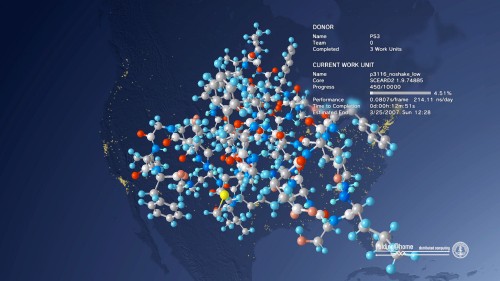Protein Folding on the Sony PlayStation 3
Unless you’re playing Half-Life 2 24 hours a day, 7 days a week, your computer has times when it’s sitting partially or totally unused. That’s a shame, because there are some really worthwhile projects that could use some extra computing power. For years, there have been distributed computing projects that let you donate your unused computer time to various causes: SETI@Home was the real pioneer, and I ran that for some time, but in recent years, I’ve run software for protein folding.

Protein folding on the PS3
Now comes another really cool advance in distributed computing: the use of video game consoles! The latest generation of video game consoles couple some pretty impressive computing power with an internet connection… that makes it a perfect resource to tap into. Stanford’s Folding@Home project has announced a client for the new Sony PlayStation 3. Since the PS3 has such great graphics capabilities, that means you can also watch Folding@Home in action in real time, and can see the 3D dimensions of the protein being folded. [via Kotaku]
After the jump, I’ll offer up my grossly oversimplified explanation of why protein folding is so important. Read on, if you’d like to know more…
Proteins are what make things happen in your body. They are the critical cogs in the machine that is your body. Proteins are created by following instructions in your DNA (read my A Molecular Happening post to learn more about how that happens). Each protein is made of a chain of molecules, called amino acids. There are 21 different amino acids. When these amino acids are linked together, the chain they form doesn’t just stay in a line — it tangles up into a sort of knot. The way it tangles & collapses into a small knot is identical each and every time — and that’s the key to how proteins work. Your body is essentially creating many identical copies of a self-assembling, 3-dimensional puzzle piece. It’s pretty fascinating, and very cool. These proteins, once they’re finished forming and collapse into their functional shape, then go and find other proteins and bits and pieces that fit, perfectly, into their shape. A dance of proteins combining and releasing like dance partners at a square dance, is how things get done in your body. (Keep in mind — this is just my grossly oversimplified version of how it works.)
Now, sometimes, things go wacky. If there’s a mutation in the DNA, for example, then the wrong amino acid might enter the chain, and the final protein won’t collapse exactly right. And then, it can be like a clumsy elephant is trying to take part in the square dance, and everything goes kerplooie. Now, things go wrong all the time, and your body is fascinatingly good at keeping the square dance running along just fine, but sometimes these sorts of things can be the root of disease. We need a much better understanding of how proteins do their thing if we’re going to get serious about treating and preventing disease — everything from cancers, Alzheimers, multiple sclerosis, diabetes; the way we treat these diseases today is going to look like leeches from the not too distant future.
With advances in genomics and genetics over the past couple of decades, there has been an explosion of data around what the sequence of amino acids are in proteins. But knowing how that particular sequence actually folds — ah, now that’s a slippery fish. These proteins, you see, are damned small. And some of them are terrifically rare. It’s not like you can catch them in action in a petri dish.
But what we can do is take what we do know about how proteins generally fold, and what we know about the sequences of proteins, to start predicting the folding patterns of proteins that are implicated in disease — and get a look at how variations in the protein might affect folding. It’s possible, but boy howdy, does it take some massive computers. Or — it takes a massive amount of small computers. And that’s where you and your little old Dell desktop come in.
If you’d like to put your computer to use, take a look at the World Community Grid (my former co-worker and Twister buddy Rich Bonneau has worked with the World Community Grid on protein folding) and Folding@Home projects.
p.s. — I’ve just created a new team on the World Community Grid for Junkyard Clubhouse — if you choose to run the World Community Grid software, please join the Junkyard Clubhouse team (you can do a search when you sign up, or click this link after registering)!


I’ve been running this program for about a month now and I have no clue what the different ball and stick colors mean, and what’s the significance of them.
posted on April 24th, 2010 at 6:58 pm